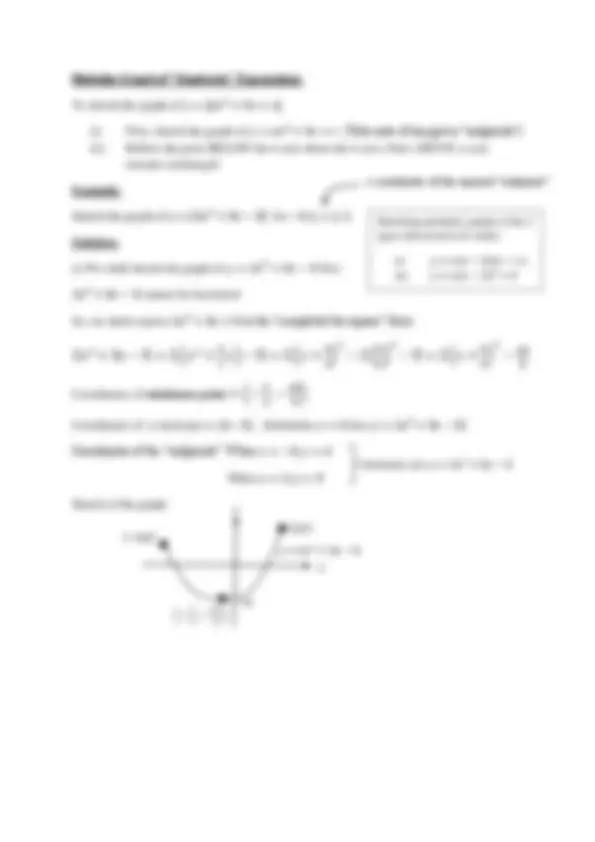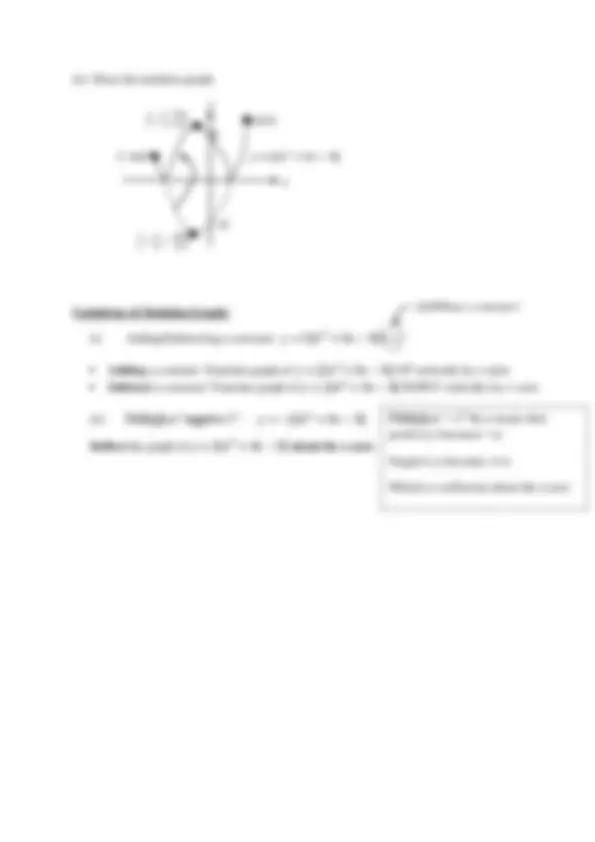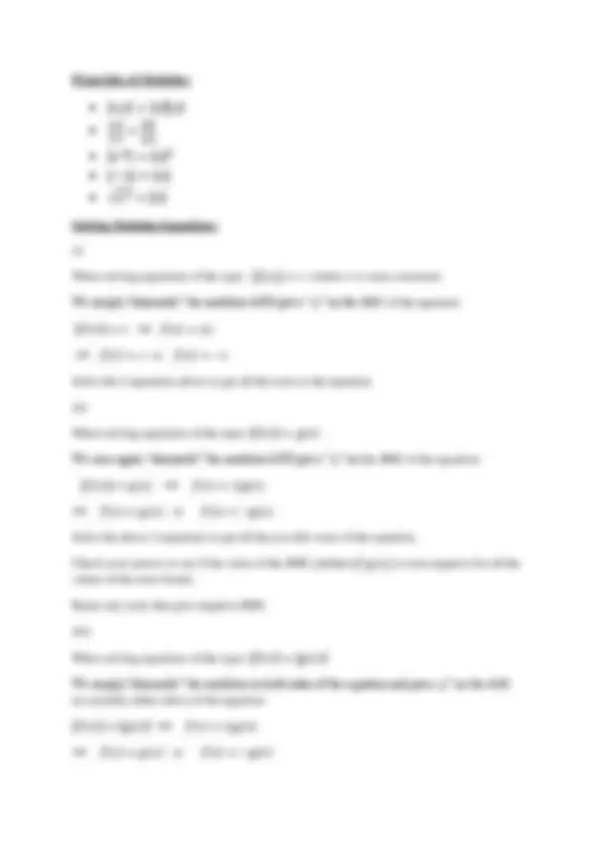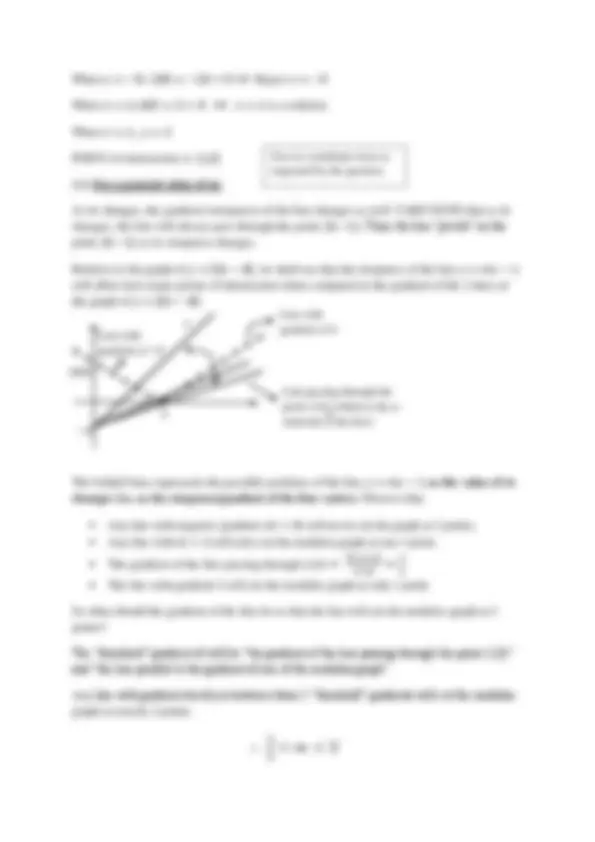






Study with the several resources on Docsity

Earn points by helping other students or get them with a premium plan


Prepare for your exams
Study with the several resources on Docsity

Earn points to download
Earn points by helping other students or get them with a premium plan
Community
Ask the community for help and clear up your study doubts
Discover the best universities in your country according to Docsity users
Free resources
Download our free guides on studying techniques, anxiety management strategies, and thesis advice from Docsity tutors
A detailed explanation of how to find the maximum and minimum points of a modulus function, as well as the equation of the line of symmetry. It includes steps for determining the shape of the graph, finding the coordinates of the minimum/maximum point, and sketching the graph. The document also covers the reflection of the graph about the x-axis and the importance of the sign of the expression inside the modulus.
What you will learn
Typology: Study notes
1 / 8

This page cannot be seen from the preview
Don't miss anything!





Definition of Modulus:
Graph of 𝑦 = |𝑥|:
Graph of 𝒚 = 𝒂|𝒙 + 𝒃| + 𝒄 : (Modulus of linear graphs)
Finding coordinates of Maximum/Minimum point:
To find 𝒙 -coordinate : Let “expression INSIDE modulus” = 0 and solve for 𝑥
𝑥 + 𝑏 = 0 ⇒ 𝑥 = −𝑏 𝑦 = 𝑎|𝑥 + 𝑏| + 𝑐
To find 𝒚 -coordinate: This is just the constant being ADDED/MINUS to/from the modulus expression
𝑦 = 𝑎|𝑥 + 𝑏| + 𝑐
Line of symmetry of 𝑦 = 𝑎|𝑥 + 𝑏| + 𝑐: The vertical line 𝑥 = −𝑏
Steps:
(i) Determine the Shape of the Modulus Graph ( V-shaped or inverted-V shaped ) (ii) Determine the Coordinates of the Minimum/Maximum Point (iii) Find the 𝑦-intercept (Substitute 𝑥 = 0 into the equation) (iv) Indicate the “Max/Min” Point and the “𝑦-intercept” on the graph (v) Sketch the graph by connecting the 2 points in (iv) with the Shape in (i)
𝑥 if 𝑥 ≥ 0
−𝑥 if 𝑥 < 0
If the expression inside the modulus is negative , then we “ multiply a negative 1 ” to the entire expression inside the modulus; Otherwise, the expression remains unchanged
𝑦
𝑥
The action of multiplying a “− 1 ” to an expression in graphical terms is to “ reflect” the graph about the 𝒙 - axis
𝑦 = |𝑥|
Equation of the graph (for 𝑥 ≥ 0 ): 𝑦 = 𝑥
Equation of the graph (for 𝑥 < 0 ): 𝑦 = −𝑥
Reflected about 𝑥-axis
Line ar means: graph is a “line” (expression MUST be of the form involving "𝑎𝑥 + 𝑏" )
𝑎 > 0 ∶ Shape of graph is a “V-shaped”
𝑎 < 0 ∶ Shape of graph is an inverted “V-shaped”
Minimum point = (−𝑏, 𝑐) Maximum point = (−𝑏, 𝑐)
This is the 𝑦-coordinate
Let this expression = 0
𝑥 = −𝑏
𝑥 = −𝑏
(−𝑏, 𝑐)
(−𝑏, 𝑐)
Modulus-Graph consists of 2 graphs, the “POSITIVE” version and the “NEGATIVE” version
Example 1:
Sketch the graph of: 𝑦 = 3 − |2𝑥 − 1|. [This is the “modulus-linear” Graph]
Solution:
Since the coefficient of the “modulus-term” is negative, the graph is a “inverted-V”.
Coordinates of “Maximum” point (since it is an inverted-V) = (^12 , 3)
𝑦-intercept: Substitute 𝑥 = 0, 𝑦 = 3 − |−1| = 2
Graph:
Example 2:
Find the value of the constants 𝑎, 𝑏, 𝑐, 𝑑 and 𝑒 given the modulus graph below:
Solution:
From the coordinates of the maximum point, 𝑒 = 5 and 2 + 𝑑 = 0 ⇒ 𝑑 = −
To find 𝑐, simply substitute a known non-maximum point into the equation:
Substitute (8,0)^ into the equation 𝑦 = 𝑐|𝑥 − 2| + 5: 0 = 𝑐|8 − 2| + 5 ⇒ 𝑐 = − (^56)
Now, using the symmetry of the modulus graph about its “maximum” point (just like quadratic graphs), 𝑎 = 2 − (8 − 2) = −
Substitute 𝑥 = 0, 𝑏 = − 56 |−2| + 5
𝑦
𝑥
𝑦
𝑥
𝑦
𝑥
∴ 𝑏 = (^103)
(ii) Draw the modulus graph:
Variations of Modulus-Graph:
(i) Adding/Subtracting a constant: 𝑦 = |2𝑥^2 + 3𝑥 − 5| + 𝑐
Adding a constant: Translate graph of 𝑦 = |2𝑥^2 + 3𝑥 − 5| UP vertically by 𝑐 units Subtract a constant: Translate graph of 𝑦 = |2𝑥^2 + 3𝑥 − 5| DOWN vertically by 𝑐
(ii) Multiply a “negative 1”: : 𝑦 = −|2𝑥^2 + 3𝑥 − 5|
Reflect the graph of 𝑦 = |2𝑥^2 + 3𝑥 − 5|^ about the 𝒙 -axis
𝑦
𝑥
(− 3 , 4 )
( 2 , 9 ) 5
(− 34 , 498 )
(− 34 , − 498 )
− 5
𝑦 = | 2 𝑥^2 + 3 𝑥 − 5 |
Add/Minus a constant 𝑐
units
Multiply a “−1” to 𝑦 means that: positive 𝑦 becomes – ve
Negative 𝑦 becomes +ve
Which is a reflection about the 𝑥-axis
Properties of Modulus:
𝑥
|𝑥| |𝑦|
Solving Modulus Equations:
(i)
When solving equations of the type: |𝑓(𝑥)| = 𝑐 (where 𝑐 is some constant):
We simply “dismantle” the modulus AND put a “±” on the 𝑅𝐻𝑆 of the equation:
|𝑓(𝑥)| = 𝑐 ⟹ 𝑓(𝑥) = ±𝑐
⟹ 𝑓(𝑥) = 𝑐 or 𝑓(𝑥) = −𝑐
Solve the 2 equations above to get all the roots to the equation.
(ii)
When solving equations of the type: |𝑓(𝑥)| = 𝑔(𝑥)
We once again “dismantle” the modulus AND put a “±” on the 𝑅𝐻𝑆 of the equation:
|𝑓(𝑥)| = 𝑔(𝑥) ⟹ 𝑓(𝑥) = ±𝑔(𝑥)
⟹ 𝑓(𝑥) = 𝑔(𝑥) or 𝑓(𝑥) = −𝑔(𝑥)
Solve the above 2 equations to get all the possible roots of the equation.
Check your answer to see if the value of the 𝑅𝐻𝑆 (𝑣𝑎𝑙𝑢𝑒 𝑜𝑓 𝑔(𝑥)) is non-negative for all the values of the roots found.
Reject any roots that give negative 𝑅𝐻𝑆.
(iii)
When solving equations of the type: |𝑓(𝑥)| = |𝑔(𝑥)|
We simply “dismantle” the modulus on both sides of the equation and put a ±” on the 𝑅𝐻𝑆 (or actually either sides) of the equation:
|𝑓(𝑥)| = |𝑔(𝑥)| (^) ⟹ 𝑓(𝑥) = ±𝑔(𝑥)
⟹ 𝑓(𝑥) = 𝑔(𝑥)^ or 𝑓(𝑥) = −𝑔(𝑥)
(i) Sketch the graph of: 𝑦 = |2𝑥 − 4|
A line of gradient 𝑚 passes through the point (0, −1).
(ii) In the case where 𝑚 = 3, find the coordinates of any point of intersection of the line and the graph of 𝑦 = |2𝑥 − 4| (iii) Determine the set of values of 𝑚 for which the line intersects the graph of 𝑦 = |2𝑥 − 4| in two points.
Solution:
(i) It is the modulus of a linear function: Coefficient of the modulus term is “+VE”, Shape: V-shape Coordinates of “Minimum” point = (2,0) 𝑦-intercept = (0,4)
Shape:
(ii) In the case where 𝒎 = 𝟑: (this is only applicable to part (ii))
Line passes through the point (0, −1) ⟹ The line have a 𝑦-intercept of −
∴ Equation of the line is: 𝑦 = 3𝑥 − 1 [Equation of line]
At the point of intersection: [We are solving a pair of equations simultaneously]
𝑦 = 3𝑥 − 1 --- (1)
𝑦 = |2𝑥 − 4| --- (2)
Substitute (2) into (1): 3𝑥 − 1 = |2𝑥 − 4|
3𝑥 − 1 = ±(2𝑥 − 4)
3𝑥 − 1 = 2𝑥 − 4 OR 3𝑥 − 1 = −(2𝑥 − 4)
𝑥 = −3 or 𝑥 = 1
Since the non-modulus side of the equation (LHS of the equation) consists of 𝑥-terms, we must check whether the non-modulus side of the equation is non-negative for the 2 solutions.
𝑦
( 2 , 0 )^ 𝑥
( 0 , 4 )
When 𝑥 = −3: 𝐿𝐻𝑆 = −10 < 0 ⟹ Reject 𝑥 = −
When 𝑥 = 1: 𝐿𝐻𝑆 = 2 > 0 ⟹ 𝑥 = 1 is a solution.
When 𝑥 = 1, 𝑦 = 2
POINT of intersection = (1,2)
(iii) For a general value of 𝒎:
As 𝑚 changes, the gradient (steepness) of the line changes as well. TAKE NOTE that as 𝑚 changes, the line will always pass through the point (0, −1). Thus, the line “pivots” on the point (0, −1) as its steepness changes.
Relative to the graph of 𝑦 = |2𝑥 − 4|, we shall see that the steepness of the line 𝑦 = 𝑚𝑥 − 1 will affect how many points of intersection when compared to the gradient of the 2 lines of the graph of 𝑦 = |2𝑥 − 4|:
The bolded lines represents the possible positions of the line 𝑦 = 𝑚𝑥 − 1 as the value of 𝒎 changes (i.e. as the steepness/gradient of the line varies). Observe that:
Any line with negative gradient (𝑚 < 0) will never cut the graph at 2 points. Any line with 𝑚 > 2 will only cut the modulus graph at one 1 point.
0−(−1)
1 2 The line with gradient 2 will cut the modulus graph at only 1 point.
So what should the gradient of the line be so that the line will cut the modulus graph at 2 points?
The “threshold” gradient of will be “the gradient of the line passing through the point (2,0)” and “the line parallel to the gradient of one of the modulus graph”.
Any line with gradient strictly in between these 2 “threshold” gradients will cut the modulus graph at exactly 2 points.
Give in coordinate form as requested by the question
Line with gradient of − 2
Line with 𝑦 gradient of 2
2 𝑥
( 0 , 4 )
− 1
Line passing through the point (2,0) [which is the 𝑥- intercept of the line]